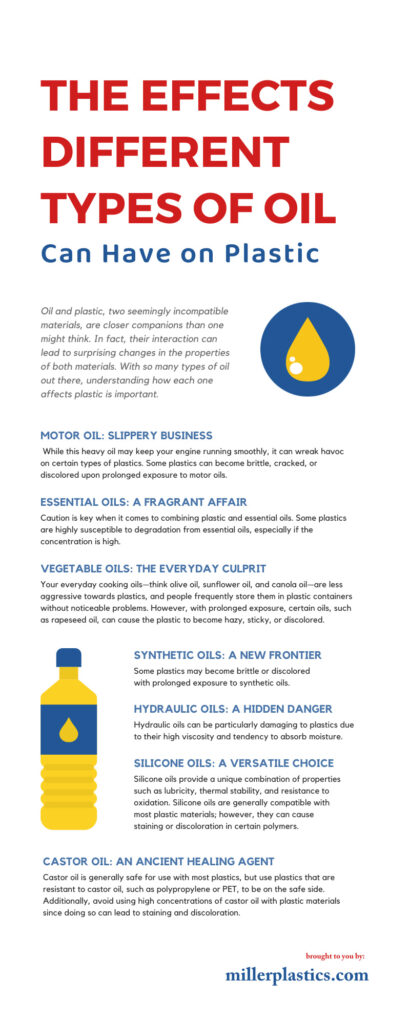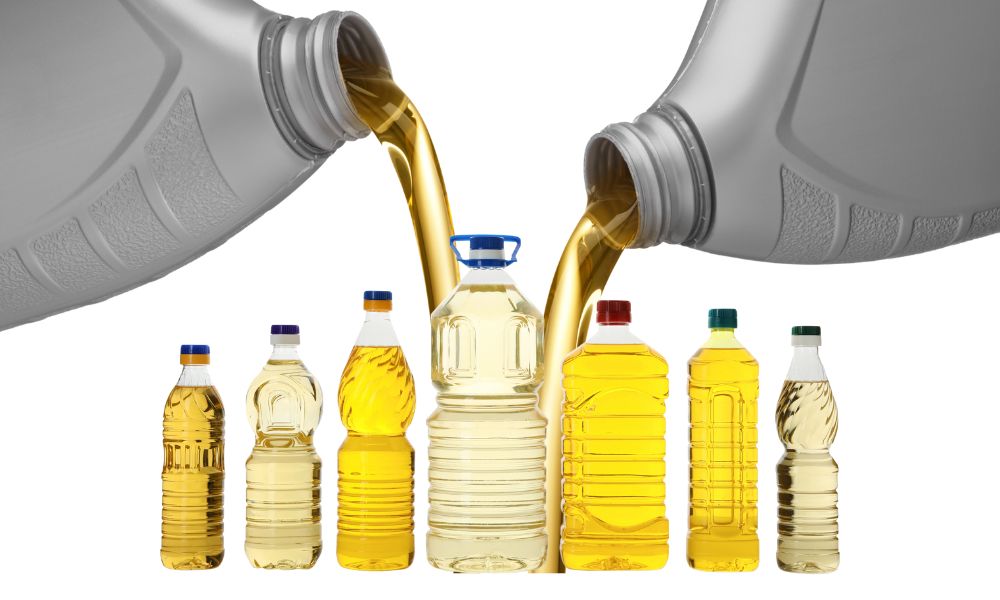Oil and plastic, two seemingly incompatible materials, are closer companions than one might think. In fact, their interaction can lead to surprising changes in the properties of both materials. With so many types of oil out there, understanding how each one affects plastic is important. Sometimes oil interaction causes disastrous consequences, and other times, it introduces a whole new world of possibilities. Join us as we explore the effects different types of oil can have on plastic and how this knowledge could potentially save your products from disaster.
Motor Oil: Slippery Business
Our first contender is motor oil, a common substance in automobiles and machinery. While this heavy oil may keep your engine running smoothly, it can wreak havoc on certain types of plastics. Some plastics can become brittle, cracked, or discolored upon prolonged exposure to motor oils. Always opt for plastics that are compatible with motor oils, such as nylon, polypropylene, or certain types of high-density polyethylene.
Essential Oils: A Fragrant Affair
Essential oils have surged in popularity for aromatherapy, skin care, and natural remedies. However, caution is key when it comes to combining plastic and essential oils. Some plastics are highly susceptible to degradation from essential oils, especially if the concentration is high. This weakening of the plastic can lead to leaks, cracks, or worse—contamination of your essential oils. Be sure to use glass or specialized plastic containers that are resistant to essential oil degradation, such as polypropylene plastic containers.
Vegetable Oils: The Everyday Culprit
Your everyday cooking oils—think olive oil, sunflower oil, and canola oil—are less aggressive towards plastics, and people frequently store them in plastic containers without noticeable problems. However, with prolonged exposure, certain oils, such as rapeseed oil, can cause the plastic to become hazy, sticky, or discolored. You should use plastic containers made from materials such as polyethylene or polypropylene for long-term storage of such oils.
Synthetic Oils: A New Frontier
A laboratory creates these products using complex chemical processes, often resulting in improved properties compared to their natural counterparts. While these synthetic lubricants perform well under extreme conditions, they can be more aggressive to plastics than natural oils. Some plastics may become brittle or discolored with prolonged exposure to synthetic oils. Selecting plastics rated for use with specific synthetic oils is crucial to ensure compatibility. Examples include polybutylene terephthalate (PBT), nylon, and acetal, which are all suitable for use with synthetic lubricants.
Mineral Oils: An Age-Old Ingredient
Developers of mineral oils extract them from petroleum, paraffin, or coal tar sources. These oils are clear and odorless and find use in a variety of products ranging from cosmetics to lubricants. While mineral oil is generally safe for use with most plastics, it can have an adverse effect on certain types of polyethylene. Use plastics that are resistant to mineral oil degradation, such as high-density polyethylene (HDPE), ultra-high molecular weight polyethylene (UHMWPE), or fluoropolymers such as PTFE or FEP when packaging mineral oils.
Hydraulic Oils: A Hidden Danger
It’s also important to consider hydraulic oils. These fluids find use in a variety of industrial equipment, including construction, aerial lifts, and forklifts. Hydraulic oils can be particularly damaging to plastics due to their high viscosity and tendency to absorb moisture. As a result, some plastic materials can become brittle or crack with prolonged exposure. Use plastics compatible with hydraulic oils, such as polyethylene terephthalate (PET) and high-density polyethylene (HDPE), to prevent damage, and nylon tubing for containing hydraulic fluids.
Silicone Oils: A Versatile Choice
Silicone oils provide a unique combination of properties such as lubricity, thermal stability, and resistance to oxidation. They can also form an effective barrier between two surfaces, making them ideal for lubrication applications. Silicone oils are generally compatible with most plastic materials; however, they can cause staining or discoloration in certain polymers. Select silicone oils that are rated for use with specific materials to ensure compatibility with plastics. Examples include fluorosilicates, which work well with most types of plastics, and polydimethylsiloxanes, which are compatible with a wide variety of plastics, such as polypropylene and PET.
Perfluoropolyether Oils: Unstoppable Protection
Perfluoropolyether oils are highly stable fluids characterized by their ability to withstand extreme temperatures and pressures. This quality makes them ideal for use in high-performance applications. Moreover, they repel water and other contaminants while forming a protective barrier on surfaces.
You can use perfluoropolyether oils with most plastics. Thanks to their superior heat and chemical resistance, they’re often the lubricant of choice for extreme conditions. Polytetrafluoroethylene (PTFE) is particularly suited for use with perfluoropolyether, but other materials such as polypropylene, polybutylene terephthalate, and polyethylene are also compatible.
Castor Oil: An Ancient Healing Agent
People have been using castor oil in traditional medicine for centuries due to its anti-inflammatory and antifungal properties. Castor oil is generally safe for use with most plastics, but use plastics that are resistant to castor oil, such as polypropylene or PET, to be on the safe side. Additionally, avoid using high concentrations of castor oil with plastic materials since doing so can lead to staining and discoloration.
Aliphatic Oils: A Household Staple
These natural plant and animal-based products are commonplace in the home. People use them for everything from cleaning to lubrication. While aliphatic oils tend to be less aggressive than mineral or synthetic oils, they can still cause discoloration and weakening of certain types of plastics. Use plastics that are resistant to aliphatic oils, such as polyethylene or polypropylene, to avoid any damage.
Now that you know about the effects different types of oil can have on plastic, it’s time to make some choices. It’s important to select the right type of plastic for storing oils. Doing so will ensure the safety of your products and keep them looking their best. Fortunately, you have plenty of options when it comes to oil-resistant plastics.
Consider investing in Miller Plastics’ polypropylene plastic containers if you want to safely store oils in plastic containers. Our containers resist degradation from the most common types of oils, allowing you to confidently store your products. Contact us today to learn more about our selection of plastic containers and other products.





